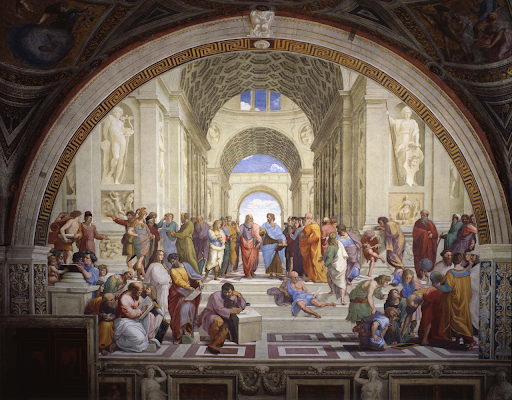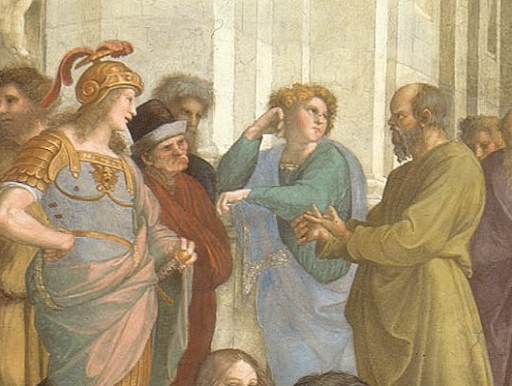How Raphael Showed Us The Whole Picture Of Socrates In The School of Athens

In the famous fresco The School Of Athens, Raphael depicted many different ancient philosophers, thinkers, and scientists. Socrates was one of them. Without a doubt, the most famous depiction of Socrates stemmed from Plato’s books. In what ways can we see Plato’s Socrates in the School of Athens?
Socrates In The School Of Athens

The School of Athens is a fresco painted by Italian renaissance artist Raphael between 1509 and 1511 to decorate the Apostolic Palace in the Vatican. It depicts a scene of famous philosophers and thinkers of the past, all standing around having conversations and debating with each other.

Traditionally, the old bald man wearing a green robe was believed to be Socrates. Raphael’s drawing of Socrates’s head was believed to be largely based on a Hellenistic portrait of him. In the fresco, Socrates is talking to a group of his students.
Attributes Of Socrates And His Listeners

We know that Socrates liked to question people who thought they knew everything in the open market place. As Socrates pointed out in his trial (Plato’s Apology of Socrates), those who listened to his questioning were largely “people who have most leisure” or “the sons of the very rich”. Raphael showed this attribute in his work very well. There are two pretty young men among his listeners. The young man with blonde curly hair wearing armor is most likely the Athenian general Alkibiades, and another young man wearing gorgeous green and blue robes with short blonde hair has been identified as Aischines of Sphettos. Both of them are upper-class young men that fit the attribute of Socrates’s listeners.
Second, in comparison to the pretty faces and gorgeous clothes of the young listeners, Socrates’s pale brown robe is much plainer. In Socrate’s trial, he revealed that he undertook to teach people and charge no fee for it. That means Socrates did not have a money-earning job. He was poor relative to the upper class according to Plato. Raphael showed Socrates’s poverty and plainness by the striking contrast between the handsome young men’s gorgeous clothing and Socrates’s plain robe and ugly appearance.
The Statue Above Socrates

This statue of the young male holding a lyre is Apollo. He is the god of truth, prophecy and oracles, music, and poetry. Why did Raphael put Apollo’s statue upon Socrates? In The Apology of Socrates, Socrates told us that his friend Chaerephon went to Delphi and ventured to ask the oracle if anyone was wiser than Socrates, and the Pythian replied that no one was wiser than Socrates. This is why Socrates acted in obedience to Apollo as an investigator to question people. Thus, Raphael’s composition of Apollo’s statue is intentional to reveal Apollo was the special patron deity of Socrates.
The Revelation Of Plato And Socrates’s Ideas About Knowledge

Let’s move to the center of Raphael’s work, the two undisputed main subjects: Plato and Aristotle. The most notable feature of them is their hand gestures. According to Jessica Stewart, “Plato’s gesture toward the sky is thought to indicate his Theory of Forms. Conversely, Aristotle’s hand is a visual representation of his belief that knowledge comes from experience.” As argued by E.J. Duckworth, based on the split of the two central figures’ ideas, Raphael divides the groups of philosophers into two types: idealists on the left side and realists on the right side.
Then, why did Raphel put Socrates to the left side? In Euthyphro, Socrates questioned the professional priest Euthyphro and devoted himself to finding a concrete definition of piety. At first, Euthyphro tried to define piety by referring to many pious actions. Then, Socrates responded, “Bear in mind then that I did not bid you tell me one or two of the many pious actions but that form itself that makes all pious actions pious” (The Trial and Death of Socrates, 13). We don’t know it’s Socrates believing there are Forms behind physical objects or it’s Plato using Socrates as a character to express the idea of Forms. Due to the close relationship between them or their ideas, it’s reasonable to put Socrates in the left side of the work right next to Plato.
The Significance Of The School Of Athens
Besides Socrates, Plato, and Aristotle, Raphael also depicted many other ancient Greek thinkers in the School of Athens like Ptolemy, Pythagoras, Heraclitus and so on. These figures all lived at different times, but here they are gathered together by Raphael under one roof. This fresco represents all the greatest thinkers, philosophers and scientists from classical antiquity gathered together sharing their ideas. This integration of ancient Greek thinkers shows how the people of the Renaissance worshipped the Greek culture and desired for a return to antiquity and classicism. They thought that the Greeks and Romans as having the greatest inventions and knowledge in history and thought that their monuments could never match those of antiquity.
Jessica Stewart praised the School of Athens as the “ marriage of art, philosophy, and science” and the “hallmark of the Italian Renaissance”. By creating the fresco, Raphael again brought ancient Greek philosophers back to people’s attention in the renaissance. He wishes us to see how reason is truly multicultural and trans-historical. Just as Dong Wang argued in his post, “The knowledge of western civilization can also be beneficial for any individual in American society. Plato’s account of Socrates still can help people better understand the struggle of democracy.” Raphael’s the School of Athens also expresses the idea that all the shining classic thoughts will never be outdated. As Raphael’s fresco shines for several hundred years, the thinkers and the thoughts in it are also remembered through the generations.
Author
Hi, I am Derrick Qu, the author of this article! I am now a sophomore in Colgate University. I am very interested in philosophy and now major in philosophy. If you have questions about this article or some simple thoughts, welcome to talking with me! Thank you for reading!